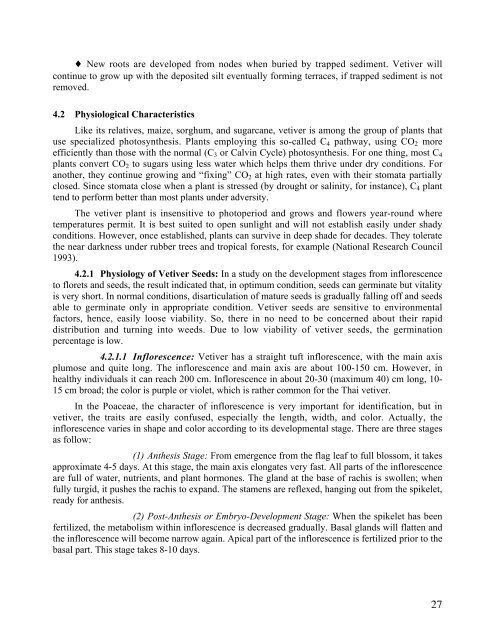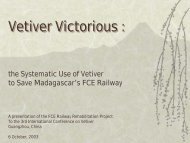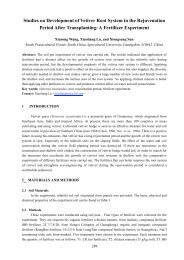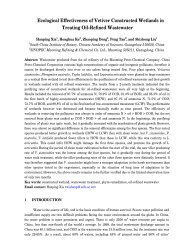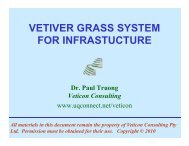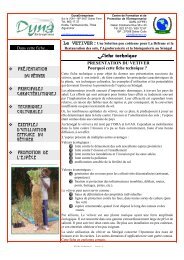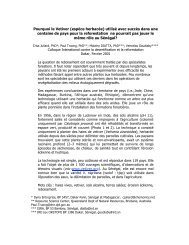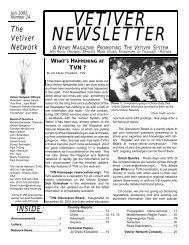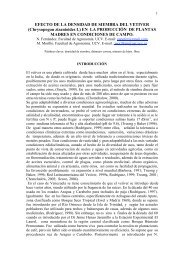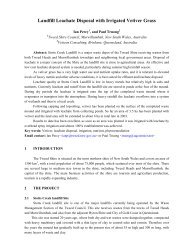Training manual - The Vetiver Network International
Training manual - The Vetiver Network International
Training manual - The Vetiver Network International
You also want an ePaper? Increase the reach of your titles
YUMPU automatically turns print PDFs into web optimized ePapers that Google loves.
♦ New roots are developed from nodes when buried by trapped sediment. <strong>Vetiver</strong> will<br />
continue to grow up with the deposited silt eventually forming terraces, if trapped sediment is not<br />
removed.<br />
4.2 Physiological Characteristics<br />
Like its relatives, maize, sorghum, and sugarcane, vetiver is among the group of plants that<br />
use specialized photosynthesis. Plants employing this so-called C4 pathway, using CO2 more<br />
efficiently than those with the normal (C3 or Calvin Cycle) photosynthesis. For one thing, most C4<br />
plants convert CO2 to sugars using less water which helps them thrive under dry conditions. For<br />
another, they continue growing and “fixing” CO2 at high rates, even with their stomata partially<br />
closed. Since stomata close when a plant is stressed (by drought or salinity, for instance), C4 plant<br />
tend to perform better than most plants under adversity.<br />
<strong>The</strong> vetiver plant is insensitive to photoperiod and grows and flowers year-round where<br />
temperatures permit. It is best suited to open sunlight and will not establish easily under shady<br />
conditions. However, once established, plants can survive in deep shade for decades. <strong>The</strong>y tolerate<br />
the near darkness under rubber trees and tropical forests, for example (National Research Council<br />
1993).<br />
4.2.1 Physiology of <strong>Vetiver</strong> Seeds: In a study on the development stages from inflorescence<br />
to florets and seeds, the result indicated that, in optimum condition, seeds can germinate but vitality<br />
is very short. In normal conditions, disarticulation of mature seeds is gradually falling off and seeds<br />
able to germinate only in appropriate condition. <strong>Vetiver</strong> seeds are sensitive to environmental<br />
factors, hence, easily loose viability. So, there in no need to be concerned about their rapid<br />
distribution and turning into weeds. Due to low viability of vetiver seeds, the germination<br />
percentage is low.<br />
4.2.1.1 Inflorescence: <strong>Vetiver</strong> has a straight tuft inflorescence, with the main axis<br />
plumose and quite long. <strong>The</strong> inflorescence and main axis are about 100-150 cm. However, in<br />
healthy individuals it can reach 200 cm. Inflorescence in about 20-30 (maximum 40) cm long, 10-<br />
15 cm broad; the color is purple or violet, which is rather common for the Thai vetiver.<br />
In the Poaceae, the character of inflorescence is very important for identification, but in<br />
vetiver, the traits are easily confused, especially the length, width, and color. Actually, the<br />
inflorescence varies in shape and color according to its developmental stage. <strong>The</strong>re are three stages<br />
as follow:<br />
(1) Anthesis Stage: From emergence from the flag leaf to full blossom, it takes<br />
approximate 4-5 days. At this stage, the main axis elongates very fast. All parts of the inflorescence<br />
are full of water, nutrients, and plant hormones. <strong>The</strong> gland at the base of rachis is swollen; when<br />
fully turgid, it pushes the rachis to expand. <strong>The</strong> stamens are reflexed, hanging out from the spikelet,<br />
ready for anthesis.<br />
(2) Post-Anthesis or Embryo-Development Stage: When the spikelet has been<br />
fertilized, the metabolism within inflorescence is decreased gradually. Basal glands will flatten and<br />
the inflorescence will become narrow again. Apical part of the inflorescence is fertilized prior to the<br />
basal part. This stage takes 8-10 days.<br />
27


